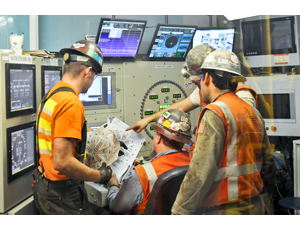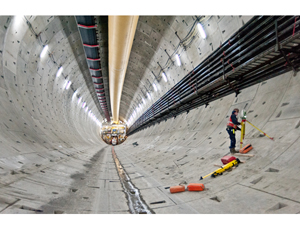Divers Searching for Way To Get TBM 'Bertha' Moving Again


Joint-venture contractor Seattle Tunnel Partners needs divers to enter the chamber behind a tunnel-boring machine’s cutting head to investigate what possibly slowed—and subsequently forced a shutdown of—North America’s largest TBM, nicknamed "Bertha." The 57.5-ft-dia TBM is attempting to bore a 1.7-mile Alaskan Way Viaduct replacement under downtown Seattle.
On Friday, Dec. 6, Bertha, which had been boring at a rate of as much as 50 ft per day under a $2-billion contract in the larger $3.1-billion project, hit a snag at 1,019.5 ft bored, with its penetration and advancement rates dropping dramatically.
“We were applying the same force and only able to move a fraction of the distance compared to what we were able to do up until that point,” says Chris Dixon, project manager for Seattle Tunnel Partners. “Rather than continually mine at high pressure with a low advance rate, we thought it best to stop and assess the situation.”
The situation requires an “intervention.”
Matt Preedy, the Washington State Dept. of Transportation’s deputy project administrator, says the top of the machine sits 55 ft below grade, with Bertha stretching over 110 ft below the surface. At this point, operators aren’t sure if the obstruction is a clog within Bertha or something in her path.
Ballard Marine Construction, a subcontractor with experience in underground-pressurized situations, is now mobilizing and plans for crews to enter Bertha’s hyperbaric plenum behind the cutter head on or around Dec. 19.
In order to perform an atmospheric intervention, in which the pressure behind the cutter head is the same as the atmosphere, crews would need to drill through the fill above the TBM and construct a device to isolate pressure. Dixon says a hyperbaric dive, in which the divers would go through Bertha’s man-lock system to compress them into the proper pressure, would allow them to get inside the plenum much sooner.
Crews will clear the plenum of material debris about halfway, visibly freeing the upper half of the cutter head. “They will see the material in the chamber below them but not all the way to the bottom, and we’ll see what information becomes available at that point in time,” Dixon says.
The progressive investigation has divers first inspecting the cutter head, mixing arms, screw intake and debris-transporting conveyer belt to see if something has worked its way into the plenum, slowing the TBM's ability to extract excavated material. Crews may have to clear more debris for a better look. Further, by gaining an outside view of the cutter head, divers may be able to see if anything external is causing the slowdown.





